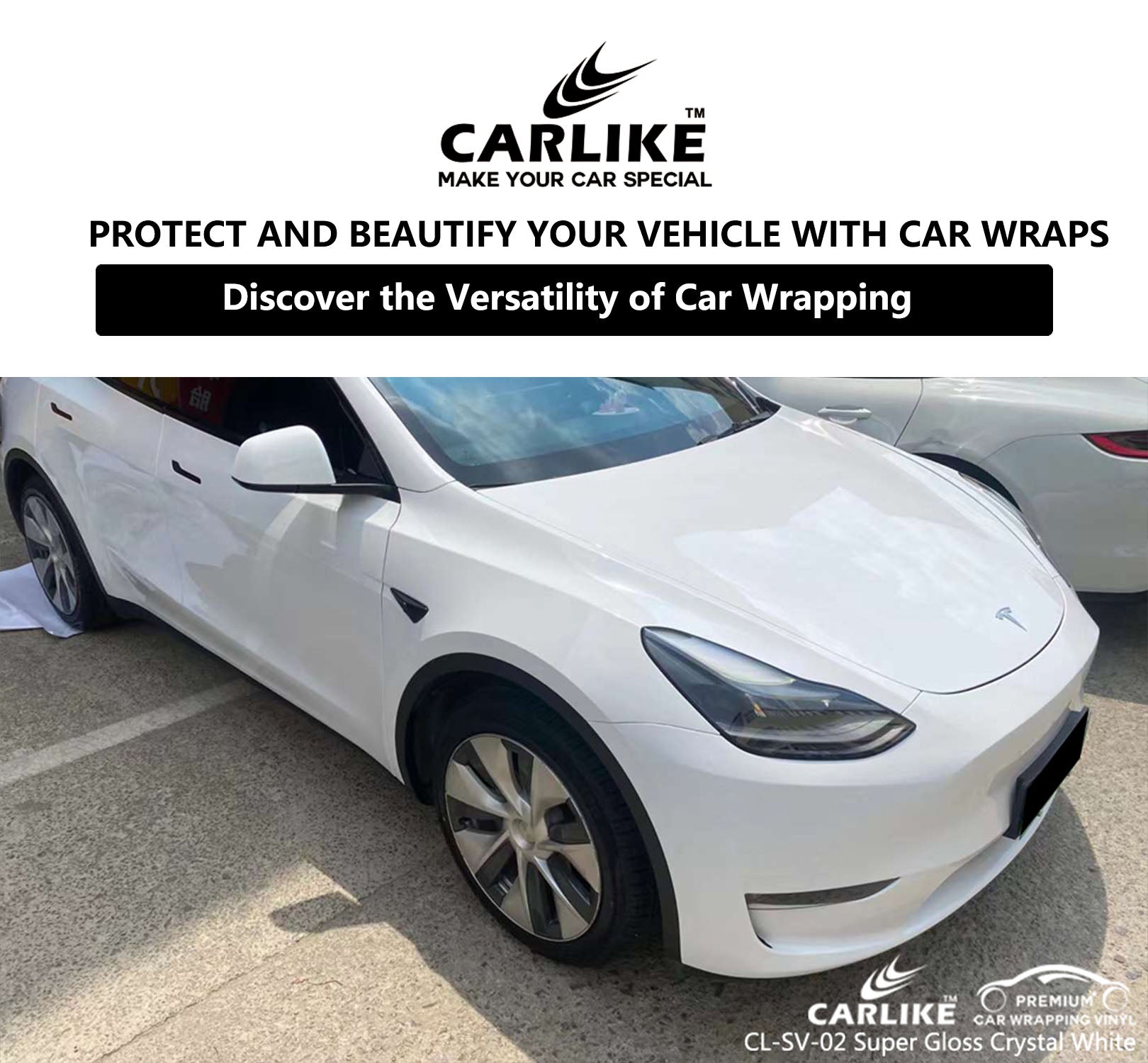Factors Affecting Car Wrapping Time
Understanding these factors can help car owners have a realistic expectation of the timeline involved in wrapping their vehicles. Here are some key factors that can influence the duration of wrapping a car:
1. Size and Complexity of the Vehicle: The size and shape of the vehicle play a significant role in determining the wrapping time. Larger vehicles, such as vans or SUVs, generally require more material and intricate installation techniques, resulting in a longer wrapping process compared to smaller cars.
2. Design Complexity: The complexity of the chosen design or artwork can impact the wrapping time. Intricate patterns, detailed graphics, or custom designs that require precise alignment and cutting may take more time to install compared to simple, solid color wraps.
3. Surface Preparation: Proper surface preparation is crucial for achieving a high-quality and long-lasting wrap. The condition of the vehicle's surface before wrapping can affect the time required. If the vehicle requires extensive cleaning, paint correction, or repairs, it will add to the overall wrapping time.

4. Removal of Existing Wrap or Paint: If there is an existing wrap or paint on the vehicle that needs to be removed before the new wrap can be installed, this process can add significant time to the project. The complexity of the removal process depends on the condition and type of the existing wrap or paint.
5. Skill and Experience of the Installer: The expertise and experience of the wrapping installer also play a role in the time it takes to wrap a car. Highly skilled and experienced professionals may be able to complete the installation more efficiently, resulting in a shorter wrapping time.
6. Environmental Factors: Environmental conditions can impact the wrapping process. Extreme temperatures, high humidity, or adverse weather conditions can slow down the installation process or require additional precautions, affecting the overall wrapping time.

7. Additional Customization: If the car owner desires additional customization such as window tinting, paint protection film, or other modifications to be done in conjunction with the wrap, it will naturally increase the overall project time.
It's important to note that while these factors influence the time required for car wrapping, the quality of the work should not be compromised for the sake of speed. A professional wrapping job requires attention to detail and precision, ensuring a flawless and durable result.
To get an accurate estimate of the time needed for your specific car wrapping project, it's recommended to consult with a professional wrapping service provider. They can assess your vehicle, discuss your customization goals, and provide you with a more precise timeline based on their expertise and experience.

Understanding the Car Wrapping Process
Car wrapping has gained popularity as an effective way to transform the appearance of a vehicle while also providing protection to its original paintwork. To grasp the concept of car wrapping, it is essential to understand the step-by-step process involved. Here is a detailed explanation of the car wrapping process:
1. Consultation and Design: The process begins with a consultation between the car owner and a professional wrapping service provider. During this stage, the car owner discusses their design preferences, color choices, and any specific graphics or branding they want to incorporate into the wrap. The service provider may also provide recommendations based on the vehicle type and desired outcome.
2. Material Selection: Once the design is finalized, the next step is to choose the appropriate vinyl material for the car wrap. There are various options available, including different finishes (gloss, matte, satin), colors, and textures. The service provider can help the car owner select the right material that suits their preferences and budget.
3. Surface Preparation: Before applying the car wrap, the vehicle's surface needs to be thoroughly cleaned and prepared. This involves washing the car to remove dirt, debris, and any wax or sealants. Additionally, the surface may undergo further preparation steps such as paint correction, removal of existing wraps, or repairs to ensure a smooth and clean base for the vinyl application.

4. Customization and Printing (if applicable): If the car wrap design includes custom graphics, logos, or branding elements, they are typically digitally printed onto the vinyl material using specialized equipment. This step requires precision and attention to detail to ensure accurate colors and sharp image quality.
5. Vinyl Application: Once the surface is prepared and any necessary customization is complete, the car wrapping process moves to the actual vinyl application. The installer carefully aligns and positions the vinyl panels on the vehicle's surface, using professional tools and techniques to avoid bubbles, wrinkles, or misalignments. The vinyl is then carefully stretched, conformed, and adhered to the contours of the car, ensuring a smooth and seamless finish.
6. Trimming and Finishing Touches: After the vinyl is applied, the excess material is trimmed using precision cutting tools to achieve clean edges and seamless transitions between panels. The installer pays special attention to details such as door handles, emblems, and body lines to ensure a professional and seamless look. Any necessary post-installation touch-ups or adjustments are made at this stage.
7. Final Inspection and Quality Control: Once the wrapping process is complete, the installer performs a thorough inspection to ensure the wrap meets quality standards. They check for any imperfections, such as air bubbles, loose edges, or misalignments, and address them as necessary. The final inspection ensures that the car wrap looks visually appealing, fits properly, and meets the car owner's expectations.
Understanding the car wrapping process allows car owners to have realistic expectations regarding the time, effort, and expertise required. It is important to note that professional installation by experienced wrap installers is crucial to achieve a high-quality and durable result.
Customization Impact: How Design Complexity Influences Wrapping Time
The more intricate and detailed the design, the longer it generally takes to achieve a flawless and professional-looking wrap. Let's explore how design complexity influences wrapping time in more detail:
1. Graphic Elements: Designs that incorporate complex graphic elements, such as intricate patterns, gradients, or detailed imagery, require meticulous attention to detail during installation. Each element needs to be aligned, positioned, and trimmed precisely to maintain the integrity of the design. This level of precision takes additional time compared to simpler, solid color wraps.
2. Cutouts and Logos: Wraps that involve cutouts for windows, door handles, emblems, or other vehicle features require careful planning and precision during installation. These elements need to be accurately measured and positioned to ensure a seamless transition between the wrapped and exposed areas. Incorporating logos or branding elements adds an extra layer of complexity, as they often require custom cutting and placement to align with the vehicle's contours.
3. Multiple Colors and Overlays: Designs that incorporate multiple colors or overlays can significantly increase wrapping time. Each color or overlay requires separate vinyl panels to be aligned and applied, adding complexity to the installation process. Ensuring precise registration between colors or overlays requires meticulous attention and expertise from the installer.
4. Vehicle Shape and Curves: The shape and curves of the vehicle also influence the complexity of the design and, subsequently, the wrapping time. Vehicles with intricate body lines, curves, or contoured surfaces pose additional challenges during the installation process. Wrapping around these complex areas requires careful stretching, conforming, and heat application to achieve a smooth and seamless finish.
Expert Tips for Streamlining Car Wrap Installation Time
Whether you're a car owner looking to wrap your vehicle or a professional installer aiming to optimize your workflow, implementing expert tips for streamlining car wrap installation time can be immensely beneficial. Here are some valuable insights and strategies to consider:
1. Thorough Planning and Preparation: Before diving into the actual installation, take the time to carefully plan and prepare. This includes measuring the vehicle accurately, assessing any potential challenges or complex areas, and developing a clear installation strategy. By having a well-defined plan in place, you can minimize the chances of encountering unexpected obstacles during the process, thus saving time.
2. Efficient Workspace Setup: Ensure that your workspace is organized and optimized for efficiency. Have all the necessary tools and materials readily available and easily accessible. A clutter-free environment helps you navigate through the installation smoothly without wasting time searching for tools or dealing with unnecessary distractions.
3. Proper Surface Preparation: Adequate surface preparation is crucial for a successful and time-efficient car wrap installation. Thoroughly clean the vehicle's surface, removing any dirt, grease, or wax that may hinder the adhesion of the vinyl wrap. Use appropriate cleaning agents and techniques recommended by the manufacturer. This step not only enhances the wrap's longevity but also helps the installation process by avoiding potential rework due to poor adhesion.

FAQ for how long does it take to wrap a car?
Q: How long does it typically take to wrap a car?
A: The time required for car wrapping can vary depending on several factors, including the size of the vehicle, complexity of the design, skill level of the installer, and whether it's a partial or full wrap. On average, it can take anywhere from one to five days.
Q: Does the type of car wrap material affect the installation time?
A: Yes, the type of car wrap material can impact the installation time. Cast vinyl wraps tend to be more pliable and easier to manipulate, allowing for faster installation compared to calendered vinyl wraps. However, the skill and experience of the installer also play a significant role.
Q: Are there any factors that can extend the car wrapping time?
A: Yes, several factors can affect the car wrapping time. These include the presence of rust or damage that needs repair, the need for extensive surface preparation, intricate or complex vehicle features, custom designs or graphics, and the level of detail involved.
Q: Can I drive my car immediately after it's been wrapped?
A: In most cases, you can drive your car immediately after it has been wrapped. However, it's advisable to follow the recommendations of the installer, as some may suggest a curing period or provide specific instructions for the first few days after installation.
Q: Can a car wrap be removed or changed easily?
A: Yes, car wraps can be removed without causing damage to the vehicle's original paint. However, it is recommended to have a professional handle the removal process to ensure it is done correctly. Changing a car wrap is relatively simple compared to the initial installation.
Final Words
In conclusion, understanding the timeline involved in car wrap installations is essential for car owners considering this transformative modification. Factors such as the size of the vehicle, complexity of the design, and the skill level of the installer all play a role in determining the duration of the process.
By following expert tips for streamlining car wrap installation time, such as thorough planning, proper surface preparation, precise cutting, and efficient teamwork, car owners can ensure a smooth and efficient wrapping experience. Whether opting for a professional installation or embarking on a DIY project, being well-informed about the process and setting realistic expectations will lead to a successful and timely car wrap transformation.








